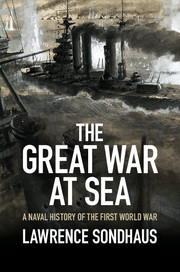Book contents
- Frontmatter
- Contents
- List of figures
- List of maps
- Acknowledgments
- Introduction
- 1 Ambition, ideology, and arms races
- 2 Preparing for war
- 3 Global prelude
- 4 European waters, 1914–15
- 5 Submarine warfare: The great experiment, 1915
- 6 Combined operations, 1915
- 7 The year of Jutland: Germany’s fleet sorties, 1916
- 8 Submarine warfare: The great gamble, 1917–18
- 9 War and revolution, 1917
- 10 Final operations
- Conclusion: Peace and naval disarmament
- Bibliography
- Index
- References
2 - Preparing for war
Published online by Cambridge University Press: 05 August 2014
- Frontmatter
- Contents
- List of figures
- List of maps
- Acknowledgments
- Introduction
- 1 Ambition, ideology, and arms races
- 2 Preparing for war
- 3 Global prelude
- 4 European waters, 1914–15
- 5 Submarine warfare: The great experiment, 1915
- 6 Combined operations, 1915
- 7 The year of Jutland: Germany’s fleet sorties, 1916
- 8 Submarine warfare: The great gamble, 1917–18
- 9 War and revolution, 1917
- 10 Final operations
- Conclusion: Peace and naval disarmament
- Bibliography
- Index
- References
Summary
“Your apparatus…would be of use to the service, if the signals could be made over three miles.” Captain Henry Jackson thus seemed to set the bar high for Guglielmo Marconi, the twenty-two-year-old Italian inventor who, three months earlier, in June 1896, had secured a British patent for his wireless telegraph. In British naval history, Jackson is best known for his eighteen months as First Sea Lord in 1915–16, served between terms of the legendary Fisher, called out of retirement at the onset of war, and Sir John Jellicoe, promoted out of command of the Grand Fleet after Jutland. But to Jackson himself, the most significant years of his career came two decades earlier, when, as captain aboard the torpedo depot ship Defiance, he joined the growing number of scientists and entrepreneurs experimenting with wireless telegraphy. In August 1896, the same month that he met Marconi, he succeeded in sending a signal nearly 55 yards (50 m), the longest working distance available to him aboard the Defiance. He soon learned that his Italian counterpart had developed equipment similar, but far superior, to his own. Indeed, the previous summer, in experiments conducted outside his native Bologna, Marconi had transmitted signals 1.5 miles (2.4 km) between two points out of sight of each other. The patriotic inventor had informed Italian authorities of the breakthrough, but they failed to grasp its significance, wished him well, and urged him to make the technology available for public use. Taking advantage of his British connections and ability to speak English (his Irish mother was heiress to the Jameson whiskey fortune), Marconi took his wireless telegraph to Britain, secured his patent, then conducted a series of demonstrations that earned endorsements from experimenters such as Jackson, who had attempted their own wireless transmissions and thus appreciated Marconi’s innovations.
In 1896, as in antiquity, men aboard a ship out of sight of land or another ship were completely cut off from the rest of humanity. That isolation was about to end. Within less than two decades, wireless telegraphy would enable navies to command and control ships at sea, over great distances, in a manner heretofore unimaginable.
- Type
- Chapter
- Information
- The Great War at SeaA Naval History of the First World War, pp. 30 - 61Publisher: Cambridge University PressPrint publication year: 2014



